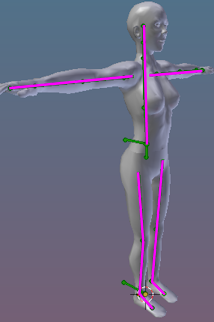About this Document...
Content:
- Avastar Templates
- Targetless IK
- Keyframes
- Export an animation
The Video content:
- Prepare an Avastar for posing.
- Inspecting the Animation System
- Create the Pose
- Export the pose for SL
What does Avastar provide?
Avastar basically supports the creation of animatable Models (Avatars&attachments) and the creation of animations. Therefore the tool adds various functions and user interface elements to Blender.
The full functionality of Avastar can be a bit overwhelming on first sight. You should be prepared to spend some time and patience to get it all working nicely for your projects.
What does this Document provide?
You learn how to create a simple (static) pose for your Avatar and export this pose for usage in Second Life.
Every aspect of 3D modelling IS artwork. And nothing works just in a couple of minutes. If you are new to Posing and animating, then please get prepared to learn a lot of tools and keep your patience. And be prepared that your results will not be perfect on the first try.
We expect that you have basic knowledge about Blender.
The art of Posing
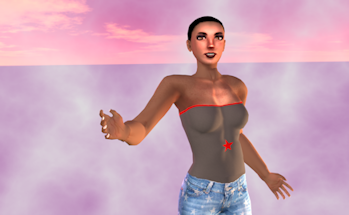
Further reading: The Basics of posing
Whenever you create a new Avastar character it will initially be displayed with arms pointing horizontally and sideways. And both feet are parallel to each other standing on ground. This pose is called the “T Pose”, apparently because the character forms the shape of the letter “T”. This pose is also the “neutral” pose. That is, the original character mesh was modeled in that pose.
Pose & Bone
The process of “posing” is nothing else than changing the neutral pose of the character by moving the character bones. And that means there must be a way to relate the bones to the mesh. This is where rigging and weighting comes into play.
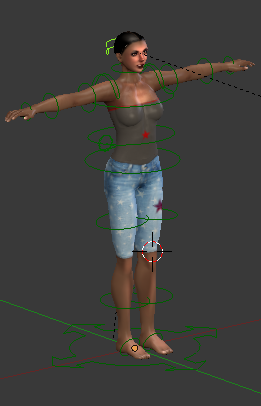
Resetting the Pose
If you want to reset your pose to the T-Pose, then select all bones (press “a” to toggle between all/none selected) and then press:
- ALT+r to reset the rotations.
- ALT+g to reset the translations.
- ALT+s to reset scaling.
Getting started
Fortunately the Avastar character is already “fully rigged and weighted”, so you are already ready for posing. Actually you are only 3 clicks away from starting your first pose:
- File -> Open template -> Avastar textured.
- Select the rig (armature) in object mode (actually it is already selected).
- Switch from Object mode to Pose mode.
Now you see “Ava” our female pose model. All bones are displayed as light green circles. Each of the circles can be selected and moved around (keyboard shortcut: “g”) and rotated (keyboard shortcut:”r”) . However, selecting and moving one bone can potentially affect other connected bones as well.
That is: Avastar has built in constraints which will move connected (chained) bones all together in a more or less natural way. This chained movement is also named targetless IK
In practice you can now go ahead and grab the bones and move them around as you like until the character is posed to your convenience. However we have added some extra information about Targetless IK which can be very helpful for your career as animator. So maybe you spend a few minutes to take a look at:

Further reading: Targetless IK
Targetless IK is enabled by default for a new Avastar character. You can see it in action when you select for example the left wrist bone and move it around (see image):
- Select the (green) bone controller of the left wrist (using the Right Mouse Button).
- Move the bone down as shown on the image (using the “g” keyboard shortcut).
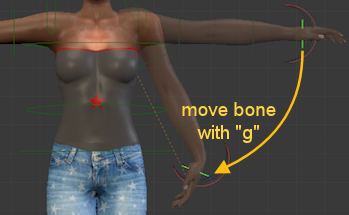
You see that while you move the bone around, the entire arm follows the hand. Thus you not only have moved one single bone with your action, but you moved all chained arm bones as well. More precisely: All bones up to the collar bone.
Bone Chains
But hold on, there is an issue. Take a close look at the left shoulder. When you inspect that area in detail, then you see an ugly distortion near the neck (see image). The pose has bended the mesh back into itself and it ended up intersecting its own surface. This can easily be fixed by rotating the collar bone back a bit and all is well.
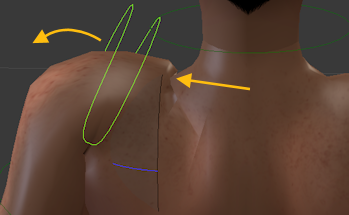
But instead of fixing the problem after it happened you could also avoid this issue completely by changing the length of the targetless IK chain, that is: exclude the collar bone from the chain. This is done with the IK Chain controller panel:
IK Chain controller
When at least one of the currently selected bones is ik enabled, then you find the Targetless IK control panel in the property sidebar of the 3D view. It is in the “Rig Properties” section.
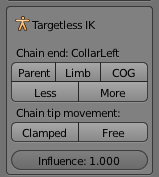
Some facts:
- We have 5 separate IK chains: two for the arms, two for the legs, and one for the Spine up to the head.
- Each chain starts at the outermost bones (wrist, foot bone, skull respectively) and by default moves up to the collars, the Hips and the torso.
- Each chain length can be changed to end at the outermost bone, or all the way up to the COG Bone (that is the Center Of Gravity bone which is located on the Avastar’s backside, just above the Pelvis).
For our purpose we want to keep the collars unaffected from our wrist movement, so what we do is this:
- Select the wrist bone.
- in the Targeless IK panel click “Less” to shorten the chain by one bone.
When you now move the wrist, then the Collar is no longer affected.
The 3D Manipulator is your friend...
The 3D Manipulator allows to move and rotate bones just by click and drag. In particular i found the Rotate manipulator very handy to quickly adjust bones. In this context the Normal orientation setting makes most sense as it aligns the manipulator always to the selected bone’s orientation and thus the rotation axes are always oriented in a meaningful way regardless of the current Viewport angle and bone angle.
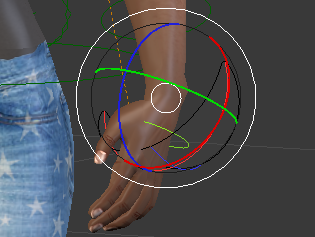
For example you always will rotate the wrist (green circle), wave hands up/down (red circle) and sideways (blue circle) regardless of the parent bones, the object orientation and the viewport angle.
You find the 3D manipulator Settings in the footer of the 3D View.
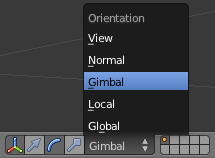
A detailed description of the 3D Manipulator and its orientation modes can be found in the Transform Orientation page in the Blender Wiki.
Finish the Posing
By now you have learned:
- How to move bones with the “r” and “g” shortcuts.
- How to use the IK Chain controller and.
- You know a bit about the 3D Manipulator.
So please go ahead and tweak the hand pose further by moving and rotating the affected bones to your wishes. Then go on with posing the right hand. And when you are done, then you will have created something like seen in the image on the right side (or something very different just as you want the pose to be).
But please take care here. Normally you will also want to adjust the Torso bone as well to get a tiny bit of more life into the character and let it look less static.
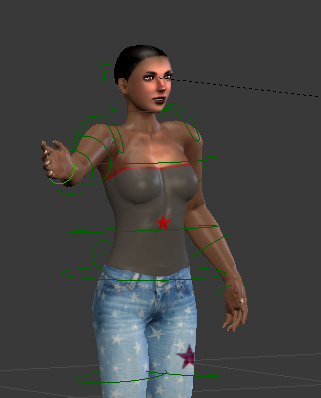
How you pose your characters is your personal taste and from here on it is up to your artistic eye to decide how to finish this task. Some knowledge about anatomy can be of great help.
Keyframes and all the reset...
Pose and Animation
We know (or maybe just guess) that an animation is something dynamic, like a set of changing poses displayed over time. And a pose is something static, where the character does not move.
While this is in principle correct, technically a pose is exactly the same as an animation. Only that the “set of changing poses” contains only one pose which gets replayed in an endless loop.
For the pose all we need to specify is which bones shall be positioned where. So we could just record all bone locations. But practically it is sufficient to only record the changed bones. This recording is done by creating Keyframes in the Timeline
Keyframes & Timeline
The Timeline: is a recording of animation changes over time. Thus whatever movement happens for whichever bone, it is stored in the timeline.
The timeline can be found in the lower part of the default Blender screen. There is also a timeline cursor available, a green vertical line, initially set at position 0 (zero) in the timeline. Note that timelines are always attached to Objects. In our case the timeline is attached to the Avastar character.
A Keyframe: is a set of bones and their transformation data (location, rotation, scales) at a specific point in time. A keyframe does not need to store all character bones. It is sufficient when it stores just the bones which have been modified since the last keyframe.
Create a Keyframe
Creating a keyframe for a pose is really easy.
- Select all bones that have been changed to make the pose.
- While the mouse cursor is in side the 3D view, press the “i” key on the keyboard.
- A Popup Box appears.
- Here we can select which transformation type shall be keyframed. Since we only have changed Location and Rotation, we will select “LocRot”.
Note: After keyframing a new yellow vertical line has appeared in the timeline at the current time position (0 in our case).
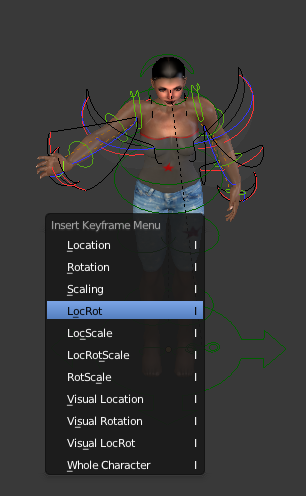
The problems raise when you later try to export your animation to SL, then your export will get rejected due to too many animated bones (SL can only handle 32 bones). The only way to get out of this is by editing the Dope sheet and deleting all Bone which do not affect the animation. This is not a funny task! So you should avoid this situation (and never keyframe the Whole Character)
Further reading: Why no head pose ?
And finally export
You find the Animation export panel in the render properties section. Although you can use the BVH-format here, we recommend that you use the anim-format, as that is the native format and gives you better precision for the final animation. Here is a list of settings which is suitable for our pose:
- Start Frame = 0 ( we only have one frame ).
- End Frame = 0
- Loop Animation = enabled (to keep pose running infinitely).
- In = 0 (Ease in and Ease out. Could be made longer, typically 0.8 secs).
- Out = 0
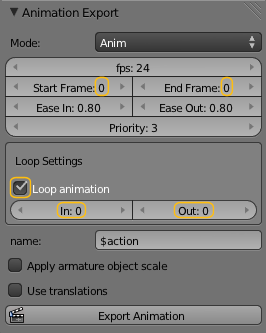
When you click on the “Export Animation” button, you end up in a file selection window. There you can can specify the export file name and location on your disk.
Upload to your online world
You can upload your animation file like you upload any other animation. In the SL Viewer you navigate to:
Build -> Upload -> Animation
